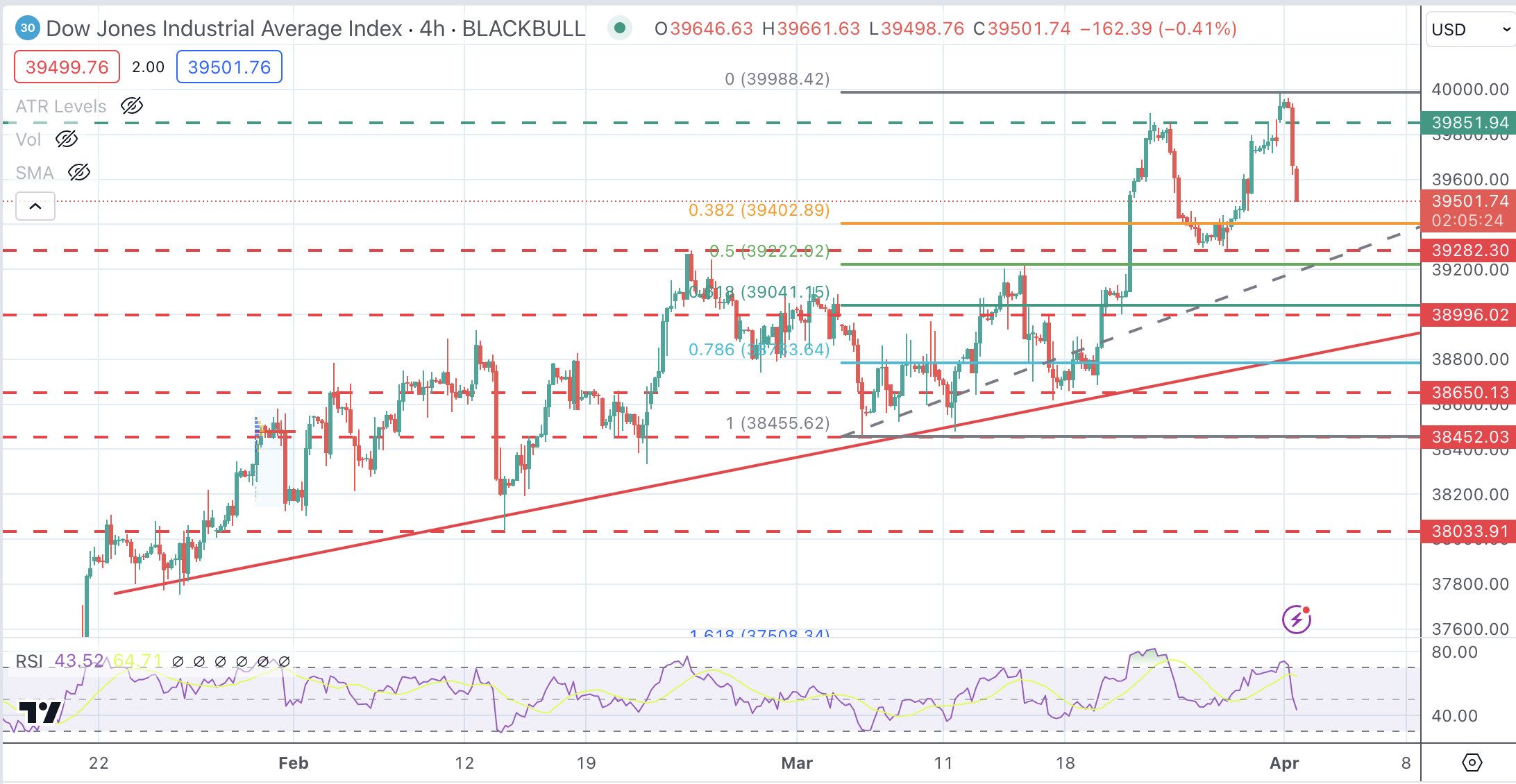- The Dow Jones corrects downwards after the good data on manufacturing activity in the United States.
- The real estate and healthcare sectors lead the losses, while communication services and energy advance.
- The DJIA corrects downwards after rejecting the psychological level of 40,000 points.
The Dow Jones Industrial Average (DJIA) suffers a significant decline this Monday. The positive surprise of the US ISM Manufacturing PMI confirms the strong momentum of the US economy and pours cold water on the US Federal Reserve's (Fed) easing expectations.
Activity in the US manufacturing sector returned to growth after more than a year of contraction. The headline PMI rose to 50.3 from 47.8 in March, beating expectations for a milder increase to 48.4. Additionally, the prices paid subindex rose to 55.8, its highest reading since July 2022 and a positive contribution to inflationary trends.
These figures are likely to support the view of Fed hawks that there is no rush to start lowering borrowing costs. This week we have a series of Fed members and key employment figures that will give us more clues about the central bank's plans.
Dow Jones News
The Dow Jones Index fell 0.56% during the Monday morning session, with most sectors in the red. The real estate and healthcare sectors lost the most, with drops of 1.29% and 1.16% respectively. On the positive side, communication services rose 1% and the energy sector advanced 0.32%.
Home Depot (HD) shares lead the declines with a drop of 2.32%, to $374.69, followed by Nike (NKE), which is down 2.16%, to $91.97. Boeing (BA) continues to bleed with the company mired in a major crisis that has led to the replacement of the board of directors. The aircraft manufacturer loses 1.59%, to $189.92.
On the positive side, 3M (MMM) outperformed the rest of the index companies with a jump of 3.63% to $91.90, followed by Microsoft (MSFT), which rose 0.7% to $423.82.
Dow Jones Technical Outlook
The Dow Jones index is experiencing a major downward correction on Monday, giving up half of the ground gained last week. The overall trend remains bullish, but the pullback from all-time highs gives bears hope of testing the support at the previous resistance level of 39,240.
The DJIA remains bullish, sitting comfortably above previous highs and the 4-hour SMA at 39,250 points. Below here, the next downside targets are at the 39,000 level and trendline support at 38,775.
Further down, the trend line resistance of the late January lows at 38,850 would be the next target.
To the upside, the resistance zone between the psychological levels of 39,850 and 40,000 looks like a tough nut to crack for the bulls.
DJIA 4-hour chart

Frequently Asked Questions About the Dow Jones
What is the Dow Jones?
The Dow Jones Industrial Average, one of the world's oldest stock indices, is made up of the 30 most traded securities in the United States. The index is weighted by price rather than capitalization. It is calculated by adding the prices of the securities that comprise it and dividing them by a factor, currently 0.152. The index was founded by Charles Dow, also founder of the Wall Street Journal. In recent years it has been criticized for not being sufficiently representative, as it only tracks 30 companies, unlike broader indices such as the S& P 500.
What factors influence the Dow Jones index?
There are many factors that drive the Dow Jones Industrial Average (DJIA). The main one is the aggregate performance of its component companies, revealed in quarterly corporate earnings reports. US and global macroeconomic data also contribute, influencing investor sentiment. The level of interest rates, set by the Federal Reserve (Fed), also influences the DJIA, as it affects the cost of credit, on which many companies largely depend. Therefore, inflation can be a determining factor, as well as other parameters that influence the decisions of the Federal Reserve.
What is the Dow theory?
The Dow Theory is a method for identifying the main trend of the stock market developed by Charles Dow. A key step is to compare the direction of the Dow Jones Industrial Average (DJIA) and the Dow Jones Transportation Average (DJTA) and only follow trends where both are moving in the same direction. Volume is a confirmation criterion. The theory uses elements of maximum and minimum analysis. The Dow theory proposes three phases of the trend: accumulation, when the smart money begins to buy or sell; public participation, when the general public joins the trend; and distribution, when the smart money abandons the trend.
How can I trade with the DJIA?
There are several ways to trade the DJIA. One of them is to use ETFs that allow investors to trade the DJIA as a single security, instead of having to buy shares of the 30 companies that comprise it. A prominent example is the SPDR Dow Jones Industrial Average ETF (DIA). Futures contracts on the DJIA allow traders to speculate on the future value of the index, and options provide the right, but not the obligation, to buy or sell the index at a predetermined price in the future. Mutual funds allow investors to purchase a portion of a diversified portfolio of DJIA securities, providing exposure to the global index.
Source: Fx Street
I am Joshua Winder, a senior-level journalist and editor at World Stock Market. I specialize in covering news related to the stock market and economic trends. With more than 8 years of experience in this field, I have become an expert in financial reporting.







